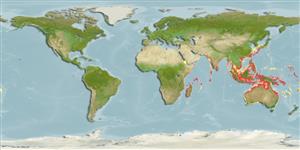Common names from other countries
>
Eupercaria/misc (Various families in series Eupercaria) >
Labridae (Wrasses) > Bodianinae
Etymology: Choerodon: Greek, choiros = a pig + odous = teeth (Ref. 45335); referrring to the prominent anterior canines of the species in this genus (Ref. 116605).
More on author: Valenciennes.
Environment: milieu / climate zone / depth range / distribution range
Sinh thái học
Biển Cùng sống ở rạn san hô; Mức độ sâu 10 - 60 m (Ref. 9710), usually 10 - 20 m (Ref. 2334). Tropical
Indo-West Pacific: Ryukyu Islands south to Australia and Indonesia. Reported from Mauritius (Ref. 5503).
Length at first maturity / Bộ gần gũi / Khối lượng (Trọng lượng) / Age
Maturity: Lm ?, range 24 - ? cm
Max length : 100.0 cm TL con đực/không giới tính; (Ref. 2272); Khối lượng cực đại được công bố: 15.5 kg (Ref. 2334)
Các tia vây lưng cứng (tổng cộng) : 13; Các vây lưng mềm (tổng cộng) : 7; Tia cứng vây hậu môn: 3; Tia mềm vây hậu môn: 10. Large adults appear blue underwater and usually have a small black spot at the dorsal fin base. Juveniles have a large white saddle spot following the black spot (Ref. 48636). A moderately small but prominent dark spot present on body at base of last dorsal-fin spine (spot not extending onto fin membrane). Body scales each with a blue centre in life forming horizontal rows of spots on side. Second prominent anterior canine in lower jaw distinctly shorter than first in adults, directed mostly dorsally and slightly anteriorly. 3 to 5 scales on subopercle. (Ref 9823)
Inhabit flat sandy or weedy areas near lagoon and seaward reefs (Ref. 9710). Solitary. Feed mainly on hard-shelled prey including crustaceans, mollusks and sea urchins. Marketed mostly fresh. In Hong Kong live fish markets (Ref. 27253).
Oviparous, distinct pairing during breeding (Ref. 205).
Randall, J.E., G.R. Allen and R.C. Steene, 1990. Fishes of the Great Barrier Reef and Coral Sea. University of Hawaii Press, Honolulu, Hawaii. 506 p. (Ref. 2334)
IUCN Red List Status (Ref. 130435)
CITES (Ref. 128078)
Not Evaluated
Threat to humans
Harmless
Human uses
Các nghề cá: Tính thương mại; Nuôi trồng thủy sản: Tính thương mại; cá để chơi: đúng; Bể nuôi cá: Tính thương mại
Các công cụ
Special reports
Download XML
Các nguồn internet
Estimates based on models
Preferred temperature (Ref.
115969): 24.5 - 29, mean 27.9 (based on 478 cells).
Phylogenetic diversity index (Ref.
82804): PD
50 = 0.5000 [Uniqueness, from 0.5 = low to 2.0 = high].
Bayesian length-weight: a=0.01318 (0.00582 - 0.02984), b=3.05 (2.86 - 3.24), in cm Total Length, based on LWR estimates for this (Sub)family-body shape (Ref.
93245).
Mức dinh dưỡng (Ref.
69278): 3.4 ±0.41 se; based on food items.
Thích nghi nhanh (Ref.
120179): Trung bình, thời gian nhân đôi của chủng quần tối thiểu là 1.4 - 4.4 năm (Preliminary K or Fecundity.).
Fishing Vulnerability (Ref.
59153): Moderate vulnerability (39 of 100).
